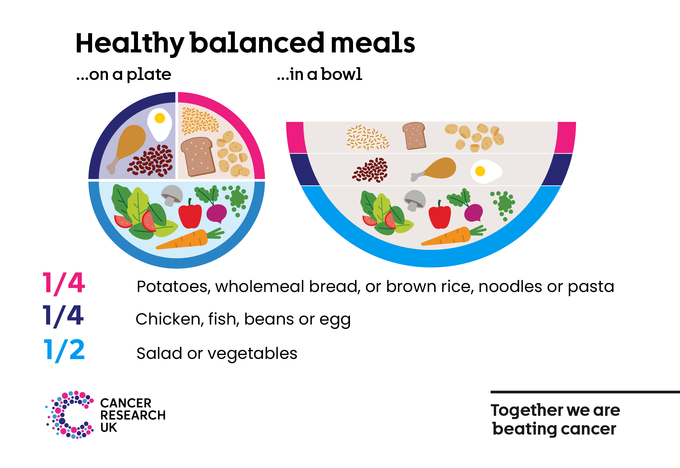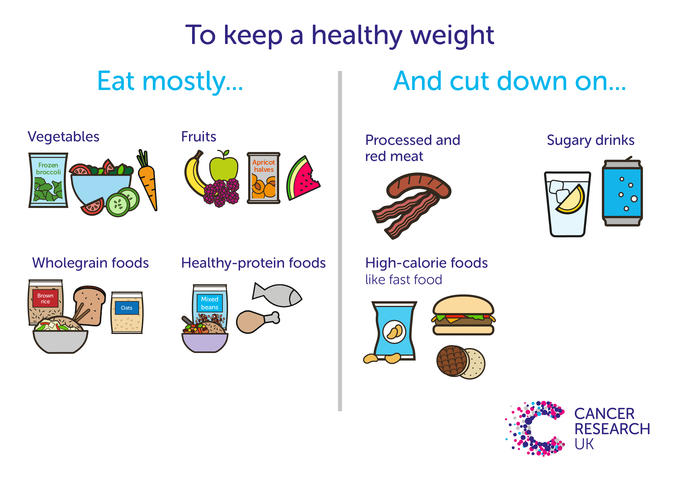What is a healthy diet?
- On this page you can find tips to help you make small changes to your diet to make it healthier. Your diet is what you usually eat and drink.
- A healthy diet has lots of fruit and vegetables, wholegrains, like brown rice or brown pasta, and healthy sources of protein like beans or chicken.
- A healthy diet is low in processed and red meat, and foods high in sugar, fat and salt.
Eating a healthy diet can lower your risk of cancer. On this page you’ll find out what a healthy diet is to help reduce your risk of cancer. We also have information for people with cancer.
What should a meal include?
When thinking about eating or cooking a meal, think about how much space each food is taking up on your plate or in your bowl.
- Eat more fruit and vegetables
Fruit and vegetables should make up a big part of what you eat every day, so think about them as the stars of the plate. When planning a meal, start with what veggies or salad you want to have and aim for this to fill at least half of your plate or bowl.
- Eat lots of wholegrains and foods that are high in fibre
Next, think about carbs that are high in fibre that you want with your veggies. So try to pick the wholegrain version, like brown pasta or brown rice. These can help you feel fuller for longer. And if you’re reaching for a snack in-between meals, you can swap crisps for plain popcorn.
Find out more about wholegrains, fibre and cancer
- Eat some healthy sources of protein and eat less processed and red meat
Finally, think about adding some protein to your meal. This could be white meat like chicken, or pulses, such as lentils and beans, or fish. Eating processed and red meat can increase the risk of bowel cancer, so try to limit how often you eat these.
Find out more about processed and red meat and cancer
- Dairy can also be part of a healthy, balanced diet
Dairy, like milk and yoghurt, can be a good source of protein, calcium and other vitamins. But the amount of fat and sugar depends on what you’re eating. Try to choose low sugar, low fat options where possible. The NHS have more on healthy dairy and dairy alternatives.
Find out more about dairy and cancer.
If you want more info on how often to eat different types of foods throughout the week, have a look at the NHS Eatwell Guide.
Everyday and occasional foods
A healthy diet isn’t all about following rules. One way to think about it is with ‘every day foods’ and ‘occasional foods’. This isn’t about strict rules or never having any less healthy foods, it’s about getting a good balance.
Occasional foods are things that we can eat every now and then but shouldn’t make up a big part of our diet every day. These foods might be slightly different for everyone but are things like cake, chocolate, biscuits and crisps. They are often high in sugar, fat or salt.
You may be surprised how much sugar is in some of your current everyday foods. We should not eat more than 7 teaspoons of sugar a day, but one bowl of some cereals can have 5 teaspoons of sugar in it, a portion of baked beans can have 2 teaspoons of sugar in it, and a half a jar of bolognese sauce can have up to 4 teaspoons of sugar.
What is a portion?
Knowing how much food to cook or eat is important. And it changes depending on the food. But this isn’t always clear when the packet tells us the portion size in grams.
To save you getting out the scales every time you’re cooking, the British Nutrition Foundation have put together a guide for practical and easy ways to get your portions right. Here are some examples:
- Dried pasta, rice, couscous or lentils – 1 portion is about two handfuls
- Potatoes – 1 portion is about the size of your fist
- Baked beans – 1 portion is half a standard 400g tin
- Eggs – 1 portion is two eggs
- Cooked vegetables, such as carrots, peas or sweetcorn – 1 portion is three heaped serving spoons
- Unsalted nuts and seeds – 1 portion is the amount that fits in your palm
- Hard cheese (e.g. cheddar) – 1 portion is the size of two thumbs
- Chicken (boneless and skinless) – 1 portion is about the size of your hand
- Sausage – 1 portion is two sausages
- Apple – 1 portion is one apple
- Vegetable oil for cooking – 1 portion is one tablespoon
How to shop healthily
Eating more healthily starts with buying healthy food at the shops. To encourage yourself to eat healthier, try these simple tricks when buying food:
- Plan your meals and make a list
- Don’t go shopping when you’re hungry
- Check the labels
If you’re not sure what to put on your shopping list, here are some cupboard and essential items that can be used in lots of healthy recipes:
- Tinned vegetables such as peas or sweetcorn
- Frozen vegetables such as carrots and spinach
- Tinned tomatoes, tinned beans and tinned lentils
- Tinned fish, such as tuna or salmon
- Noodles
- Potatoes, garlic and onion
- Brown rice and pasta
And if something in your fridge is about to go off, consider putting it in the freezer and using it later.
How to cook quick healthy meals on a budget
We know that buying healthy food can sometimes cost more. Try these tips when cooking from scratch at home to save a bit of time and money:
- Make vegetables the stars of your meal – this will save you money as they are generally cheaper than meats.
- Reduce waste – if you’ve got any vegetables that are past their best, stick them in a soup or stew.
- Avoid frying – especially in lots of oil or butter. Instead, you can cook on a hob using tinned tomatoes as a base, or pop it in the grill or oven.
- Substitutes – low-fat natural yogurt can be used instead of creams in sauces such as curries.
- Batch cooking – for meals like curries or bolognese, cook more than you need and freeze the leftovers into portions. Then when you’re in a hurry you have a tasty, home-cooked frozen meal at the ready.
The NHS have lots of healthy recipes ideas.
British Nutrition Foundation. Find your balance get portion wise. 2019. https://www.nutrition.org.uk/putting-it-into-practice/balancing-the-diet/get-portion-wise/
NHS. The Eatwell Guide. 2020. https://www.nhs.uk/live-well/eat-well/the-eatwell-guide/
World Cancer Research Fund (WCRF) Third Expert Report https://www.wcrf.org/dietandcancer




